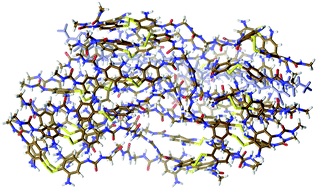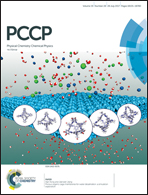The role of non-covalent interactions in the self-healing mechanism of disulfide-based polymers
Abstract
In this work, a theoretical protocol based on classical molecular dynamics has been defined, in order to study weak non-covalent interactions in diphenyl disulfide based compounds. This protocol is then used to study the influence of hydrogen bonds and π–π stacking in four selected cases, namely, monosubstituted and amine ortho trisubstituted urea and urethane-based diphenyl disulfides. In all cases, it has been observed that hydrogen bonds are much more relevant than π–π stacking, which has little influence. In addition, hydrogen bonds are the responsible to maintain the polymeric chains close, so that the disulfides may reach the reacting region, even in urethane-based materials, where the lower amount of hydrogen bonds formed make the chains more flexible and mobile. Combining the results obtained by classical molecular dynamics with those obtained earlier by means of quantum mechanics, we conclude that there are two main factors that are relevant to the self-healing properties of disulfide-based materials: firstly, the capacity to generate sulfenyl radicals by breaking the disulfide S–S bond and, secondly, the ability of these radicals to attack neighboring disulfides. The former is dominated by the bond dissociation energy of the S–S bond, while the latter is strongly influenced by two other factors. On the one hand, the hydrogen bonding interactions established between chains, and on the other, the energy barriers for the attack of sulfur radicals to neighbor disulfides. We have defined three new parameters to estimate the influence of these features, with the aim of predicting the self-healing capacity of disulfides and related materials, which will help experimentalists in the development of improved materials.



 Please wait while we load your content...
Please wait while we load your content...